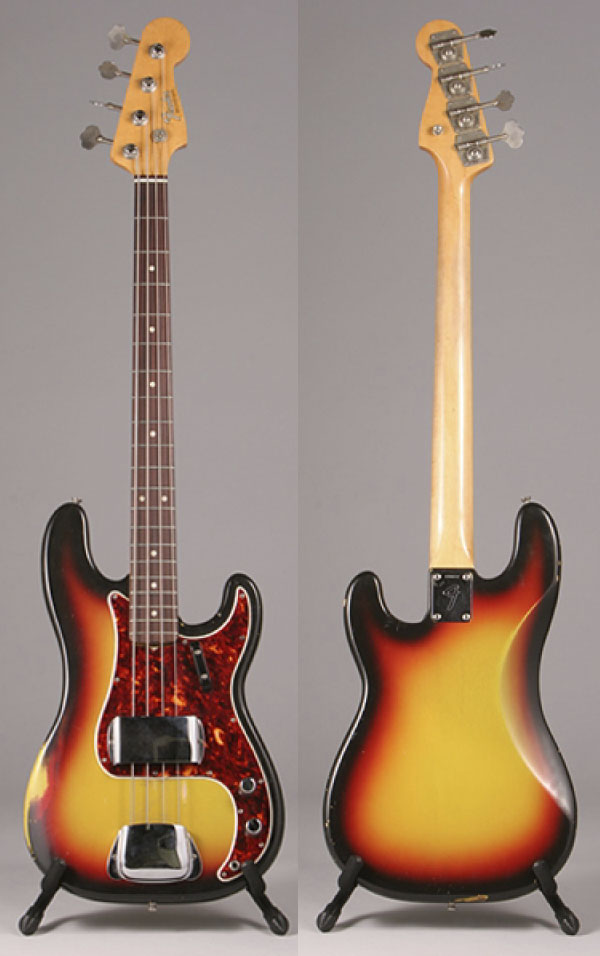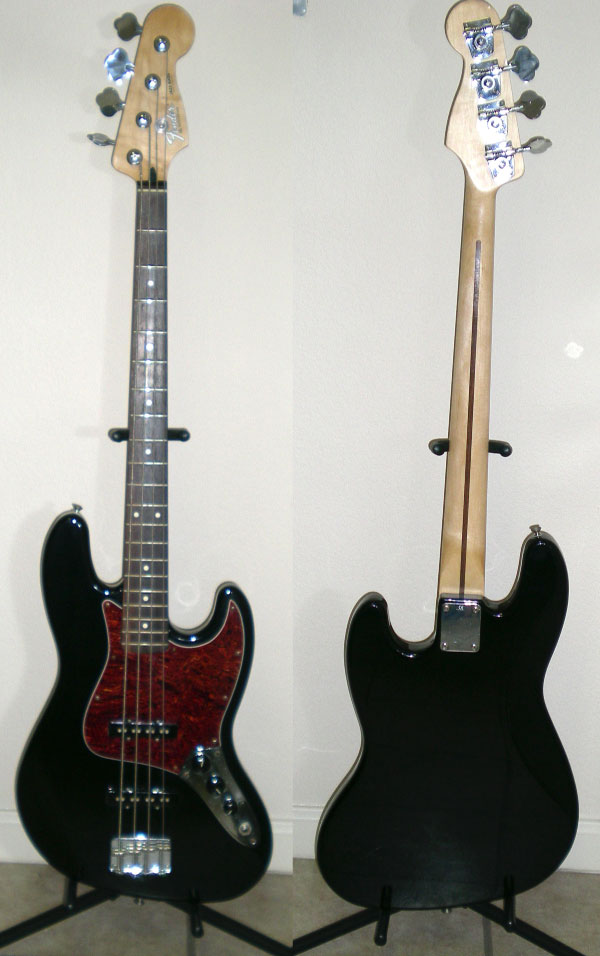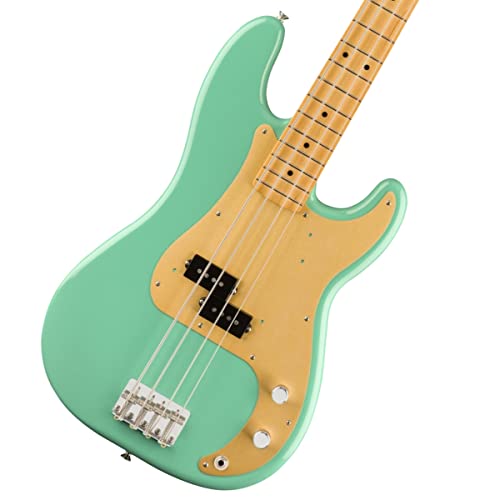Jazz Bass vs Precision Bass: what is best for you and your style of playing? What is the difference between P bass and J bass? On this page you’ll find a complete guide to Fender’s iconic bass guitars.
Index
- Introduction
- Jazz Bass vs Precision Bass
- P Bass Vs J Bass Release Dates
- Jazz vs Precision Neck
- Jazz Bass vs Precision Bass Construction
- Jazz vs Precision Bass Sound
- Bassists Who Use Jazz & Precision Basses
- Famous Precision Bass Players
- Famous Jazz Bass Players
- P Bass vs J Bass Price & Suggested Models
Introduction To The Precision Bass And Jazz Bass
Leo Fender introduced the Precision Bass in 1951, and the instrument was the first electric bass guitar to garner widespread attention among bassists.
Tired of lugging their full-sized, upright double basses from one gig to the next, bass players appreciated both the convenience of the smaller instrument, and its ability to compete in volume with the horn sections (and new-fangled electric guitars) of the day.
The Jazz bass, introduced almost a decade later, featured numerous design changes that differentiated it from its predecessor.
Today, these ground-breaking bass guitars are among the best-known of all electric instruments, and are used by a multitude of players across a wide variety of musical genres.
On this page, we discuss the differences between the Jazz Bass and the Precision Bass.
We pay particular attention to the instruments' respective construction, sound and playability. We also list famous bassists who use each model, and finally take a look at selected Jazz and Precision Bass models in Fender’s range.
Below is a round-up of the main differences between the Jazz Bass and the Precision bass:
Jazz Bass vs Precision Bass
- The Precision Bass was introduced in 1951; the Jazz Bass in 1960.
- The Jazz Bass was originally aimed at jazz bassists, hence the name; the Precision Bass was named for its fretted neck, which allowed bassists, who were used to playing fretless, upright basses, to play notes with “precise” intonation.
- The Jazz Bass has a brighter, more midrange-heavy tone than the Precision Bass.
- Both the J-bass and P-bass have solid bodies with dual cutaways.
- The body of the Jazz bass has an offset lower bout, similar to that of a Fender Jazzmaster; while the Precision Bass, with its symmetrical “waist”, is shaped more like a Telecaster or Stratocaster.
- In its standard configuration, the Jazz bass features two single-coil pickups, while the Precision Bass usually has a single pickup (either a humbucker or single-coil).
- Both Jazz and Precision basses usually have 20 frets.
- Both basses have bolt-on necks, but the necks feel very different. The J bass tapers as you get to the nut, while the P bass has a far meatier feel at the nut, and is thick all the way through the neck.
- Typically, the bodies of both basses are made from either ash or alder (although poplar and basswood are also used) and the necks are made of maple.
- The Jazz bass has two volume controls and one tone control; the Precision bass has one tone control and one volume control.
You can see suggested Jazz and Precision bass models at a range of different price points further down the page.
P Bass Vs J Bass Release Dates
The Jazz Bass (or “J-bass”), and the Precision Bass (or “P-Bass”), are Fender’s flagship bass guitars, and between them have defined the sound of electric bass for decades. You’ve almost certainly heard both of these instruments on hit records in virtually every genre of modern music.
The Fender Precision bass, introduced in 1951, was the world’s first mass-produced solid-bodied electric bass. At first, bassists accustomed to using traditional upright double basses were slow to adopt to the new instrument.

Some bassists, including Elvis’ bassist Bill Black, initially struggled to play an instrument that was held perpendicular to the body. Black eventually became one of the first big names to endorse the instrument. (Source Wikipedia)
The P-Bass did find a home among session musicians, starting with Wes Montgomery’s brother and bassist Monk Montgomery, the aforementioned Bill Black (on the set of Jailhouse Rock), and Wrecking Crew bass ace Carole Kaye.
The Jazz Bass was introduced in 1960, and was originally named the “Deluxe Model”. It was renamed “Jazz Bass” to appeal to jazz bassists.

Not only did the Jazz Bass’s pickup and control configuration differ to those of the Precision bass, but the new instrument also featured an asymmetrical body shape similar to that of the Jazzmaster Guitar. A major difference in the “feel” of the two basses is that the Jazz Bass’s neck is narrower and more rounded than that of the Precision Bass.
Jazz vs Precision Bass Neck
Both the Jazz and Precision bass feature bolt-on necks made from maple. The necks have twenty frets, with modern iterations of both basses adopting Fender’s comfortable “C” shaped neck profile.
The Jazz bass has a narrower neck width at the nut of around 38mm, which slowly tapers as you get closer to the body. The P bass’s neck stays about the same size all the way up, from about 43mm at the nut.
Players looking to mix things up have been known to attach the neck of one bass to the body of the other. Players who find a tapered neck uncomfortable might use a P bass neck on a Jazz body, or those who prefer a tapered neck but like the P bass’s more understated tone might use the Jazz neck on a P bass body.
Both basses use a variety of woods for the fretboard, including maple, rosewood, pau ferro, or Indian laurel.
Jazz Bass vs Precision Bass: Body & Construction
Both Jazz and Precision Basses feature double cutaways to facilitate playing higher up on the neck. The P bass was actually the first Fender instrument to feature double cutaways, and as a result it looks more like a hybrid of the Stratocaster and Telecaster than anything else. Its body was modelled heavily on that of Fender’s successful Telecaster guitar, which is easiest to see in its lower bout and control configuration.
The Jazz bass, so named to appeal to the same group of players Leo Fender was courting with his Jazzmaster guitar, features a sleeker offset silhouette, with contours to move the body away from the player’s picking arm. Both basses were designed to be comfortable to play standing up.
Generally speaking, the bodies of both bass guitars are built from ash, alder, poplar, or basswood. Old-school P and J basses of the 1970s used ash bodies, but even earlier models were typically made from alder. Ash-bodied basses usually have a brighter tone, while alder-bodied basses tend to have a darker, warmer sound.
Jazz Bass vs Precision Bass Sound
One of the main differences between the Jazz Bass and Precision Bass is in the sound. The Jazz Bass was designed to have a more clearly defined, brighter tone than the Precision Bass. This was partially an attempt on Leo Fender’s part to bring jazz players, who wanted articulate bass tones for playing solos, into the Fender fold. Key to the tonal capacity of the Jazz bass is the option to blend the relative volumes of its two pickups. The bridge pickup, as with an electric guitar, has a more trebly sound, while the neck pickup’s tone is darker and warmer.
As a result, the Jazz bass is capable of a far broader tonal spectrum than the Precision bass. Being able to blend these tones is a major feature of the Jazz bass design.
The J-bass, when played with both pickups at full volume, has a characteristic “growling” tone that is widely used for slap bass playing. If you think of the scooped, aggressive tone of Marcus Miller or Will Lee’s bass playing, that’s a J bass with all the volume cranked. This is not dissimilar to the effect of playing a Stratocaster with two pickups activated, giving the Strat its distinctive “quacking” tone.
The Precision bass generally has a darker tone than the Jazz bass thanks to its single pickup. While players can shape their tone somewhat by altering their playing style and technique, the P-Bass generally isn’t as versatile or as aggressive-sounding as the Jazz Bass.
Its more muted sound has made the P bass a favorite among musicians who prefer their bass lines to sit low in the mix, adding power and presence. In contrast, P-bass players with a very aggressive picking style, such as Steve Harris of Iron Maiden, favor the instrument because its naturally warm tone balances out the high frequencies highlighted by their playing technique.
Bassists Who Use Jazz & Precision Basses
The Precision Bass is used in a wide range of musical genres, including jazz, soul, funk, punk, metal, and rock.
The Jazz bass, with its more ergonomic design, seems to appeal to virtuoso players, although this is not a hard and fast rule. The Jazz bass appeals to players across a variety of genres, with many of the greatest bassists of all time using this as their main instrument. Flea of the Red Hot Chili Peppers, and Geddy Lee of Rush are genuine “bassists’ bassists”, revered by their peers.
Famous Precision Bass Players
- Jet Harris (the Shadows)
- James Jamerson
- William "Monk" Montgomery
- Brian Wilson (the Beach Boys)
- Carol Kaye (the Wrecking Crew)
- George Porter Jr.
- Roger Waters (Pink Floyd)
- Donald "Duck" Dunn (Booker T. & the M.G.'s)
- Dee Dee Ramone (the Ramones)
- Sting (the Police)
- Paul Simonon (the Clash)
- Steve Harris (Iron Maiden)
- Duff McKagan (Guns N' Roses)
- Mike Dirnt (Green Day)
- Phil Lynott (Thin Lizzy)
Famous Jazz Bass Players
- Jack Casady (Jefferson Airplane, Hot Tuna)
- Noel Redding (The Jimi Hendrix Experience)
- Larry Graham (Sly and the Family Stone)
- Herbie Flowers
- Greg Lake (Emerson, Lake and Palmer)
- Jaco Pastorius (Weather Report)
- John Paul Jones (Led Zeppelin)
- Joe Osborn (The Wrecking Crew, International Submarine Band)
- Geddy Lee (Rush)
- Marcus Miller
- Flea (Red Hot Chili Peppers)
- Ron Blair (Tom Petty and the Heartbreakers)
- Adam Clayton (U2)
- Verdine White (Earth, Wind & Fire)
Jazz vs Precision Price
If you’re looking to buy either a Jazz Bass or Precision Bass, you’ll be happy to know that your choice of instrument won’t be determined by price. Both the J-Bass and P-Bass are priced very similarly at pretty much all levels.
Beginners all the way up to pros can find themselves a quality instrument, especially given Fender’s wide-ranging attention to quality control in recent years.
Total beginners are advised to look at Squier’s offerings. Squier is Fender’s budget subsidiary, making guitars from cheaper materials in China. Squier’s broad range of P and J style basses are very aggressively priced and are appropriate for beginners.
- 100% designed by Fender
- Inspired by 1970s-era Jazz Bass models
- Fender-Designed alnico pickups
- Vintage-tinted gloss neck finish
- Nickel-plated hardware
- 100% designed by Fender
- Inspired by 1970s-era Precision Bass Models
- Fender-Designed alnico pickups
- Vintage-tint gloss neck finish
- Nickel-plated hardware
Of course, if you’re a serious bass player at the intermediate or pro level, you’ll want to invest in a professional instrument.
The good news is that Fender’s Mexican factory - which is only a few hours’ drive from their top-of-the-line California factory - produces great, pro-quality Jazz and Precision basses for those not quite ready to invest in an American-made instrument.
The company’s Mexican-made “Player” range features modern, “workhorse” instruments aimed at enthusiasts and pro players; the “Vintera” line consists of era-accurate imitations of their vintage instruments.
- Alder Body with gloss finish
- Two player Series single-coil jazz bass pickups
- Two volume controls, master tone control
- “Modern C"-Shaped neck profile
- 9. 5"-Radius Fingerboard
- Single ‘50s P bass split-coil pickup
- “’50s P bass C”-shaped Maple neck; 7. 25”-Radius Fingerboard with 20 vintage-style Frets
- Alder Body
- 4-Saddle Bridge with threaded saddles
- Includes deluxe Gig Bag
Sitting at the top of Fender’s range of basses are the company’s American-made “Professional” Jazz and Precision basses. If you don’t mind dropping some serious cash on a bass guitar, this is where you should look.
- 4-string Electric Bass with Pine Body
- 2 Single-coil Pickups - Roasted Pine
- Maple Fingerboard
- Maple Neck
- 1 Split-coil Pickup - Mystic Surf Green
- 4-string Electric Bass with Alder Body
- Rosewood Fingerboard
- Maple Neck
Further Reading
Bass vs Guitar: Which Is Best For You?








